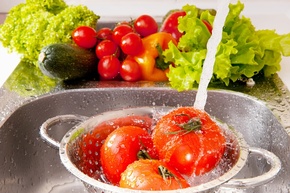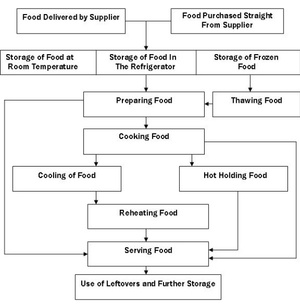What are the Food Safety Requirements for Artisans, Manufacturers, Retailers or Large Catering Organisations?
What are the food safety requirements for a food businesses?
 Every business, artisan, small, medium or large must implement HACCP Food Safety Management System?
Every business, artisan, small, medium or large must implement HACCP Food Safety Management System?
How do I implement a HACCP Food Safety Management System?
You must ensure first ensure you have the PRE-REQUISITE PROGRAMME in place.
What is a "PRE-REQUISITE" Programme?
The Pre-Requisite Programme simply means that the business follows Good Hygiene Practices (GHP) and Good Manufacturing Practices (GMP) in a documented way under the following headings:
- supplier control
 - personal hygiene and training
- personal hygiene and training
- cleaning and sanitation,
- maintenance,
- pest control,
- plant and equipment,
- premises and structure,
 - services,
- services,
- waste management,
- zoning/separation of areas
Keeping of records in relation to the Pre-Requisites is essential as part of implementing a Food Safety Management System in place and is considered an essential foundation upon which HACCP is 'built'.
My business has the PRE-REQUISITE PROGRAMME in place. How do I implement a HACCP Food Safety Management System?
There are five preliminary steps and then a further 7 steps known as "The 7 Principles of HACCP".
 1. Assemble HACCP team
1. Assemble HACCP team
- The food operation should assure that the appropriate product specific knowledge and expertise is available for the development of an effective HACCP plan. Optimally, this may be accomplished by assembling a multidisciplinary team. Where such expertise is not available on site, expert advice should be obtained from other sources, such as, trade and industry associations, independent experts, regulatory authorities, HACCP literature and HACCP guidance (including sector-specific HACCP guides). It may be possible that a well-trained individual with access to such guidance is able to implement HACCP in-house.
- The scope of the HACCP plan should be identified. The scope should describe which segment of the food chain is involved and the general classes of hazards to be addressed.
 2. Describe the product and process
2. Describe the product and process
- A full description of the product should be drawn up, including relevant safety information such as: composition, physical/chemical structure (including Moisture Content, Acidity, etc.), heat treatment, freezing, brining, smoking, etc. for elimination/reduction of hazards), packaging, durability and storage conditions and method of distribution.
- Within businesses with multiple products, for example, catering operations, it may be effective to group products with similar characteristics or processing steps, for the purpose of development of the HACCP plan.
 3. Identify intended use
3. Identify intended use
- The intended use should be based on the expected uses of the product by the end user or consumer. In specific cases, vulnerable groups of the population, e.g. institutional feeding, may have to be considered.
 4. Construct flow diagram
4. Construct flow diagram
- The flow diagram should be constructed by the HACCP team. The flow diagram should cover all steps in the operation for a specific product. The same flow diagram may be used for a number of products that are manufactured using similar processing steps.
- When applying HACCP to a given operation, consideration should be given to steps preceding and following the specified operation.
5. On-site confirmation of flow diagram
- Steps must be taken to confirm the processing operation against the flow diagram during all stages and hours of operation and amend the flow diagram where appropriate. The confirmation of the flow diagram should be performed by a person or persons with sufficient knowledge of the processing operation.
 6. List all potential Hazards and consider Controls - PRINCIPLE 1
6. List all potential Hazards and consider Controls - PRINCIPLE 1
- The HACCP team should list all of the hazards that may be reasonably expected to occur at each step of production, processing, manufacture, and distribution until the point of consumption.
- The HACCP team should next conduct a hazard analysis to identify for the HACCP plan, which hazards are of such a nature that their elimination or reduction to acceptable levels is essential to the production of a safe food.
- In conducting the hazard analysis, wherever possible the following should be included the likely occurrence of hazards and severity of their adverse health effects. Consideration should be given to what control measures, if any exist, and the controls that can be applied to each hazard. More than one control measure may be required to control hazards and more than one hazard may be controlled by a specified control measure.
 7. Determine Critical Control Points - PRINCIPLE 2
7. Determine Critical Control Points - PRINCIPLE 2
- There may be more than one CCP or there may no CCP’s. The determination of a CCP in the HACCP system can be facilitated by the application of a CCP decision tree. Training in the application of the decision tree is recommended.
8. Establish Critical Limits - PRINCIPLE 3
- Critical limits must be specified, measurable and validated for each Critical Control Point. Criteria often used include measurements of temperature, time, moisture level, sensory parameters such as visual appearance and texture.
9. Establish a Monitoring - PRINCIPLE 4
-
Monitoring is the scheduled measurement or observation of a CCP and their critical limits. The monitoring procedures must be able to detect loss of control at the CCP.
10. Establish Corrective Actions - PRINCIPLE 5
- Specific corrective actions must be developed for each CCP in the HACCP system in order to deal with deviations when they occur. The actions must ensure that the CCP has been brought under control. Actions taken must also include proper disposition of the affected product. Deviation and product disposition procedures must be documented in the HACCP record keeping.
 11. Establish Verification Procedures - PRINCIPLE 6
11. Establish Verification Procedures - PRINCIPLE 6
-
Establish procedures for verification. Verification and auditing methods, procedures and tests, including random sampling and analysis, can be used to determine if the HACCP system is working correctly. The frequency of verification should be sufficient to confirm that the HACCP system is working effectively. Verification should be carried out by someone other than the person who is responsible for performing the monitoring and corrective actions. Where certain verification activities cannot be performed in house, verification should be performed on behalf of the business by external experts or qualified third parties. Examples of verification activities include:
-
Review of the HACCP system and plan and its records;
-
Review of deviations and product dispositions;
-
Confirmation that CCP’s are kept under control.
-
Where possible, validation activities should include actions to confirm the efficacy of all elements of the HACCP system.
-
 12. Establish Documentation and Record Keeping - PRINCIPLE 7
12. Establish Documentation and Record Keeping - PRINCIPLE 7
- Efficient and accurate record keeping is essential to the application of a HACCP system. HACCP procedures should be documented. Documentation and record keeping should be appropriate to the nature and size of the operation and sufficient to assist the business to verify that the HACCP controls are in place and being maintained. Expertly developed HACCP guidance materials (e.g. sector-specific HACCP guides) may be utilised as part of the documentation, provided that those materials reflect the specific food operations of the business.

 If you are still unsure contact the office
If you are still unsure contact the office 




